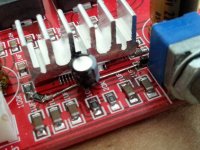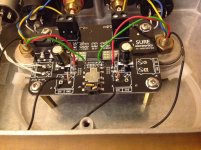Any specific model of the Astron ? I try the samsung oem smps with output 24.3VDC, not bad but seems like lower voltage sounds more smooth, I will try to lower it to 16V with a LT1084 see how it sounds.
Any of the linear supplies above 7amps should suffice. Rhing has an RS-12A I believe. I have an RS-11 or 12 (unmarked so don't remember). Older ones like mine come with the large can blue Sprague 36DX capacitor (mine is 16000uf). I've tried a bunch of different power supplies - linear, smps, and batteries and the Astron outperform them all. I paid <$50 for mine on ebay. Rhing got a minty one for $25 or so IIRC so you're not breaking the bank. Other people on another forum have reported on them for other components as well and the feedback is the same.
Not exaggerating - If improving the sound quality from these amps is a priority then you must give these power supplies a try.
Any of the linear supplies above 7amps should suffice. Rhing has an RS-12A I believe. I have an RS-11 or 12 (unmarked so don't remember). Older ones like mine come with the large can blue Sprague 36DX capacitor (mine is 16000uf). I've tried a bunch of different power supplies - linear, smps, and batteries and the Astron outperform them all. I paid <$50 for mine on ebay. Rhing got a minty one for $25 or so IIRC so you're not breaking the bank. Other people on another forum have reported on them for other components as well and the feedback is the same.
Not exaggerating - If improving the sound quality from these amps is a priority then you must give these power supplies a try.
Hi,
Do you really need 7A that much?
Hi,
Do you really need 7A that much?
Better too much than too little. Also see Tubelab (George) posts earlier in this thread (late last year I think) where he measured peak current draw for his speakers I believe around 6A. If your speakers are very efficient then okay but RS-12 and higher supplies are not that much more expensive than the 7As used.
The alternative to going for a high current supply is to have oodles of caps on the rails. I'm powering my amps from a bench supply with current meters and I've yet to see the meter go beyond 0.7A (for both channels), but the caps (around 2F) are taking care of the short term peaks.
The alternative to going for a high current supply is to have oodles of caps on the rails. I'm powering my amps from a bench supply with current meters and I've yet to see the meter go beyond 0.7A (for both channels), but the caps (around 2F) are taking care of the short term peaks.
Lol I'll take the Astron. Your Cap bank scares the bejesus out of me!
The alternative to going for a high current supply is to have oodles of caps on the rails. I'm powering my amps from a bench supply with current meters and I've yet to see the meter go beyond 0.7A (for both channels), but the caps (around 2F) are taking care of the short term peaks.
Are you running the cap bank prior to the regulator ? I have an 80 * 2000uf cap bank will try it on my linear regulator.
No, I'm running the cap bank on the output of my bench supply. Takes a while to charge up fully from cold....😛 Caps are best placed close to the amp as that's the main source of noise/ripple when a regulated supply is being used.
<edit> I just realized I underestimated the size of my cap bank since I went over to 4 channels of amplification (2 bass/mid, 2 tweeter) and added in two classB amps for the tweeters, Its more like 3F now which is probably way overkill.... I shall downgrade the tweeter amp cap banks in due course. If anyone else beyond wushuliu is scared of huge cap banks then don't go looking at this articule where there's over 300F in a preamp (not a poweramp even....).
http://www.ultraaudio.com/features/2008_07_01.htm
<edit> I just realized I underestimated the size of my cap bank since I went over to 4 channels of amplification (2 bass/mid, 2 tweeter) and added in two classB amps for the tweeters, Its more like 3F now which is probably way overkill.... I shall downgrade the tweeter amp cap banks in due course. If anyone else beyond wushuliu is scared of huge cap banks then don't go looking at this articule where there's over 300F in a preamp (not a poweramp even....).
http://www.ultraaudio.com/features/2008_07_01.htm
Last edited:
The info is probably somewhere in this thread, but which values do I need as an output filter for 16ohm speakers?
Cheers
Cheers
I think it has not been asked befor🙂 But first thing I would do is look if I can find impedance grafics for my speaker. Say impedance is flat at 16 ohm or 16 ohm at frequencies you decided that matter to your soundperception most. Next question would be what ampboard you have, do you want to use parts of existing filter? Boards with 10uH inductors will give too high cutoff frequency I think, 22uH inductors could be paired with (2) 0.1uF 100nF capacitors for very high cutoff frequency 75khz.The info is probably somewhere in this thread, but which values do I need as an output filter for 16ohm speakers?
Cheers
33uH inductors with (2) 0.15uF caps gives you 50khz cutoff frequency.
47uH inductors with (2) 0.22uF caps gives 35khz cutoff frequency
56uH inductors with (2) 0.22uF caps 32khz
Okawa filter calculator can be used to find suitable combinations, but because your amp is BTL divide speaker impedance by 2 and multiply C value by 2 for single ended formula used there.
Last edited:
Thanks for the elaborate feedback. Let me ask a very basic question: I assume it is advisable to have a rather low cutoff frequency - or not?
My board is the YJ blue board - values are still original, but inductors are by CC.
The speakers I am using are quite vintage and there is no relevant information about their impedance curve as far as I know.
Cheers
My board is the YJ blue board - values are still original, but inductors are by CC.
The speakers I am using are quite vintage and there is no relevant information about their impedance curve as far as I know.
Cheers
10uH inductors with 0.039uF caps would be Q=0.707 for 16 ohm load, ideal, but cutoff frequency will be 180khz, and the filter is meant to attenuate ~400khz. Cutoff frequency normally ~1/10 chip frequency.
At this moment if speakers are like 16 ohm load the Q=3, cutoff frequency 43khz which will have a substantial peak there and like article by Trevor Marshall shows, the amp will deliver all ampères it can at that frequency then.
I don't know, but if your speakerwires are not long best option could be ferrite beads with the snubber and little cap....if all drivers in the vintage speaker are cones
with the 180khz cutoff if impedance turns out to be 32 ohms I guess the amplifier would try to deliver peak ampères at 180khz, probably/hopefully (only) burning the resistor in the snubber on YJblue ?? not a good idea to try I think
At this moment if speakers are like 16 ohm load the Q=3, cutoff frequency 43khz which will have a substantial peak there and like article by Trevor Marshall shows, the amp will deliver all ampères it can at that frequency then.
I don't know, but if your speakerwires are not long best option could be ferrite beads with the snubber and little cap....if all drivers in the vintage speaker are cones
with the 180khz cutoff if impedance turns out to be 32 ohms I guess the amplifier would try to deliver peak ampères at 180khz, probably/hopefully (only) burning the resistor in the snubber on YJblue ?? not a good idea to try I think
Last edited:
<edit> Any interest in kickstarting a thread on TDA8932? 😀
Yes sir!

Want to reiterate y'all need to be listening to these TPAs with an Astron/TenTec linear power supply. You don't know what you're missing.
And anybody besides abrax do the pin 17 avcc RC filter yet? Come on guys there's more performance to get from these amps!
Well I am using a toroidal trafo, big caps and LM338 reg. Sounds good tho haven't tried any comparisons with SMPS.
As for pin 17 mod, just about to try it, looks like micro surgery! Got some 3.3ohm SMD resistors for it or should I use 10ohm?
How can I remove the volume of 3116D2?
I've gotten and assembled a YJ's 3116 DIY kit.
Because I need a pre amplifier, I wanna remove the volume of 3116 KIT.
Usually I fix 3116 volume at maximum and adjust volume for my pre amp, after I turn on 3116 at minimum.
I wonder how I can fix the volume at maximum without causing any pop noise.
Or Isn't there any need to do this? I think "The less connectors, The better"
Thanks.
I've gotten and assembled a YJ's 3116 DIY kit.
Because I need a pre amplifier, I wanna remove the volume of 3116 KIT.
Usually I fix 3116 volume at maximum and adjust volume for my pre amp, after I turn on 3116 at minimum.
I wonder how I can fix the volume at maximum without causing any pop noise.
Or Isn't there any need to do this? I think "The less connectors, The better"
Thanks.
It's not pretty but it works great, thanks Giancarlo! No on or off bump anymore!
View attachment 427092
YJ, and other manufacturers building PCB's and amps should take note of this very desirable feature that costs almost nothing to include.
YJ, and other manufacturers building PCB's and amps should take note of this very desirable feature that costs almost nothing to include.
Yeah about $.47 but I definitely could have gotten that price lower....especially if I lived in China.
I'm interested to see what the next wave of boards look like as in YJ 3.0. Those guys in China need to make some prototypes and send them to y'all for evaluation before they mass produce...how cheap the red boards are going for now, definitely trying to move some product along.
And anybody besides abrax do the pin 17 avcc RC filter yet? Come on guys there's more performance to get from these amps![/QUOTE]
Hi
can point me to the post regarding this mod ?
thanks
kp93300
Hi
can point me to the post regarding this mod ?
thanks
kp93300
Start here - http://www.diyaudio.com/forums/class-d/237086-tpa3116d2-amp-60.html#post3924399 subsequent posts provide further clarification.
I can report another successful input transformer modification, using Amethyst input transformers connected directly to the input pins on the TPA3110D2 chip. The transformers are specified for a 300ohm source and 10Kohm load, so not perfect for this application but good enough for testing. I now have no thump at power on (no input caps to charge). I have a pair of Lundahl LL1540 coming which should be a big step up in quality. Right now the amp sounds more relaxed and spacious than with a single ended source and coupling caps.
Attachments
- Home
- Amplifiers
- Class D
- TPA3116D2 Amp

